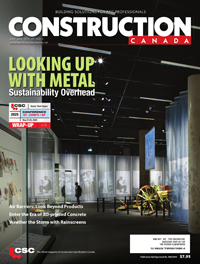Surveying the 2023 design/construction landscape
The specified slider id does not exist.
For 13 years, Construction Canada has conducted an annual survey to gather insights from readers about the state of the industry. The survey offers a glimpse into the daily operations of the architecture, engineering, construction, and operation (AECO) professionals who are responsible for designing, constructing, and maintaining various structures such as condominium towers, hospitals, schools, and offices.
Construction Canada is the official publication of Construction Specifications Canada (CSC). An interdisciplinary association, CSC brings together professionals from across the building industry. Its membership includes architects, specifiers, engineers, project managers, product manufacturers’ representatives, contractors, and other experts across the architecture, engineering, and construction spectrum.
While the majority of the survey respondents are not CSC members, the participation of a diverse group of professionals provides a broader perspective on the current state of the industry. The survey covers a range of topics such as income, social media usage, job satisfaction, and future predictions. Hundreds of participants across the country provided insights into the current state of the industry and potential future trends.
Once again, we received responses from various parts of Canada, including every province and even territories, with Ontario having the most survey participants this year, comprising 162 respondents. British Columbia and Alberta followed as the second and third most represented provinces, respectively, similar to last year’s results. There has been a slight decrease in the percentage of female respondents, who now make up 24 per cent of the total, down from 27 per cent in the previous two surveys. However, it is noteworthy that female respondents reported earning salaries of $100,000 or more at a higher rate this year, with 42 per cent compared to 22 per cent last year. In contrast, 50 per cent of male respondents reported the same, down slightly from 51 per cent last year. Despite a significant age gap remaining, with more than half of the surveyed individuals over the age of 50, there has been an increase in the number of new entrants to the industry this year, rising from 12 to 14 per cent. Further, there has been a notable shift in the occupational longevity category, with nearly half of all participants having been in the industry for 30 years or more. Architects continue to be the largest group of respondents, with representation from specifiers, engineers, project managers, and general contractors as well.







